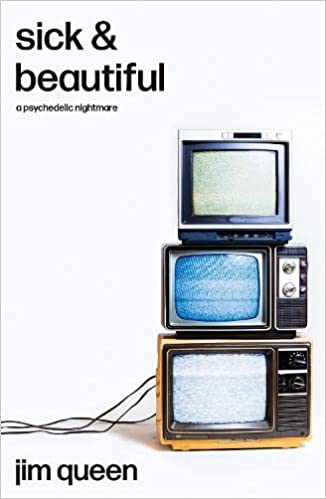Having recently read and reviewed Jim Queen’s debut novel, I was also keen to run an interview: it’s such a heady, hedonistic book, for starters, that it begs many questions. But more than that, I was interested in its back story, so to speak: it’s a book which feels both very alienating and yet very personal, so I knew that hearing about the process behind it would be intriguing. Jim was kind enough to oblige, and so without further ado…
WP: Before writing Sick & Beautiful – your debut novel – you’ve worked as a non-fiction writer, a journalist and copywriter. Talk to us about making that leap from one kind of writing to another: is fiction something that you’ve always wanted to do? And how challenging has it been to move from one into another?
Writing (and re-writing) such a beefy piece of work between the gaps of daily life is undeniably the biggest challenge. But I’d say the leap between each discipline isn’t a huge one. Journalists are never truly objective. They’ve also utilised fictional techniques since the 1960s New Journalism movement. Copywriting for brands and advertisers follows the same rules: you’re aiming to evoke an emotional response with a toolbox of verbal and visual tricks, just like a hack or a novelist. And the best fiction always reflects reality. This is what enables your readers to connect with the characters, even when your narrative tailspins into the surreal and fantastical. In that sense, I’ve always wanted to write a novel, but I’ve never wanted to write fiction.
WP: Your protagonist, David, is also a journalist who finds his way into a dreamlike world, where truth and fiction overlap. It’s an often dizzying sensory experience, written in such a way that David often comes across as quite vulnerable to what overtakes him. Was this your intention? And how hard was it to balance David’s very real traumas and feelings against the fantastical events which occur?
From blurring past, present and future, to overlapping reality with nightmares and drug-induced hallucinations, I wanted David’s first-person view to be capricious and disorientating. I don’t think there’s anything more powerful in storytelling than an unreliable narrator. But my desire to muddy these boundaries isn’t just to make the reader draw their own interpretations: it’s to make them question the borders of their own reality.

This intent was inspired by a quote from JG Ballard, speaking about his experience living in a civilian prison camp in Shanghai: “The realities that you took for granted – your comfortable day-to-day life, school, the home where one lives, familiar streets, the trips to the swimming pool and the cinema – were just a stage set. They could be dismantled overnight.”
The notion that everyday reality might not be what we assume, that it can all be altered or taken away, is fascinating and frightening. This possibility crushes David. It heaves him between fearless hope and hopeless dread. Ultimately, David’s vulnerability (and his growing awareness of it) is his biggest strength. Even as he transforms into a monster, his vulnerability makes him more human.
WP: Rachel Garland, who precipitates (or seems to precipitate) a lot of the novel’s developments, is an interesting character: what inspired this muse-like woman – if that’s a fair way to describe her? How do you think you intend your readers to think about her, or the relationship between her and David?
There’s a wonderful line from Lisa Taddeo’s Animal: “There is nothing in the world better than the past.” This is how we can understand Rachel. We never truly know who she is – instead, Rachel is an effigy of David’s hopes, fears, aspirations and memories. She implores us to question the muses and vocations in our own lives. Are the people and ideologies we latch ourselves onto what we assume? Or are they a mirror of our obsession, a symptom of a culture that renders individuals into objects? Like David, Rachel reflects those uncomfortable (and sometimes unbearable) truths.
WP: Sick & Beautiful, wherever else it takes us, is rooted in London – it suggests a deep knowledge, and a fondness for London. Please tell us more about this – why was it important to you as a key setting?
London isn’t just a location: it’s a character. And the architecture and personality of that character drives the narrative. It warps and informs David’s emotional state – an endless tug-of-war between infatuation and repulsion. It also facilitates an environment where atrocities can occur every minute, every hour, every day. This setting illustrates how humanity is a carousel of death and violence. The city, as well as the events of Sick & Beautiful, are just a snapshot of this grotesque merry-go-round. We can watch our senseless destruction with disgust and horror, but we can’t reverse or escape it.
WP: Your love of the horror genre is clear in the book, and you have included some horrific set pieces which would not be amiss in horror cinema. The book as a whole seems to idolise cinema, writing cinematic knowledge into your characters’ back stories and using locations which would be known to film fans – to name just a few of the connections. Why was this important to you?
I’ve been a horror fanatic since childhood (and, admittedly, I spent more time watching Blockbuster rentals than reading books). I don’t believe there is a genre more qualified to exhume darkness and beauty than horror. The role of horror cinema in Sick & Beautiful, and David’s fetishisation of it, is a device to cloud the peripheries of reality. But it’s also a love letter to an artform I idolise. This novel is my way of giving something back, and hopefully something unique, to the horror canon.
WP: What was the most challenging part of this writing journey? And where do you hope to go next, in terms of your writing?
Something Chuck Palahniuk underscores in Consider This: “I’ve known fantastic writers who never finished a project. And writers who launched incredible ideas, then never fully executed them.” In short, the biggest challenge is finding the time to write your first draft, shredding it to pieces, and then re-rewriting and proofing it more times than you can count.
That writing process, at least in my experience, is chaotic, unromantic and spiritually draining. But it can be absolving too. Nothing is more cathartic than killing characters you loved, writing without fear or shame, and allowing people to critique what works in your story (and, most vitally, what doesn’t).
I’ve taken these lessons onboard for the next book and, so far, the journey has been less painful. But the story itself? It’s weird. And it’s frightening. Really frightening. I just want to get it out of my brain so the nightmares will go away again.
Many thanks to Jim Queen for his time!
